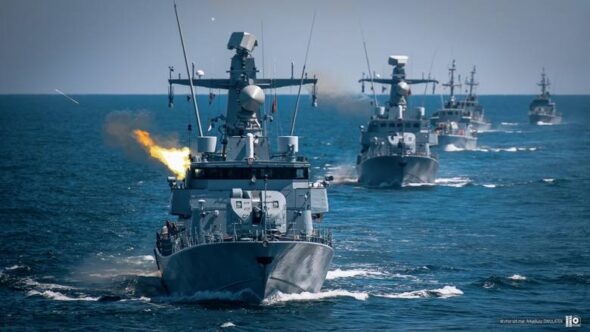In recent years, Poland has opened to the Baltic Sea in unprecedented ways. However, no political force that was in power after 1989 has treated the Baltic as an area worth protecting, and the Polish Navy as a kind of armed forces worth investing in and modernizing. This is especially dangerous considering, for instance, what happened in Ukraine. It’s time to act – Mariusz Marszałkowski, editor at BiznesAlert.pl, writes.
102 years of the Polish Navy
November is an important month in the history of the Polish Navy. In November the flags on the ORP Piorun destroyer and ORP Jastrząb submarine and the most famous destroyer ORP Błyskawica were hoisted. In November 1939 the Polish Navy Division was established in Great Britain, which was the cradle of Polish statehood in exile. However, the most famous November moment in the modern history of Poland’s Navy was the Marshal of Poland Józef Piłsudski’s decree from 28 of November 1918. The act was short in content, but major in importance: „On 28 of November 1918, I hereby order to establish a Polish Navy and I appoint navy colonel Bogumił Nowotny as head of the Navy Department at the Military Issues Ministry,” the order says. Therefore, on the 28th of November 2020, the Polish Navy celebrated its 102nd anniversary. That’s it when it comes to celebrating that event.
What is the Baltic to Poland?
Poland’s coastline is 770 km long, out of which 440 km is the state’s maritime border. The area of Poland’s territorial waters (without internal waters, e.g. the Bay of Gdańsk) has 8.783 sq km (almost as much as the Opolskie Voivodship), whereas the area of Poland’s Exclusive Economic Zone is 22.595 sq km. It is close to the size of the West Pomerania Voivodship.
The territorial waters are an area where a given country has sole legal jurisdiction, whereas the Exclusive Economic Zone allows the said country to pursue its economic interests, e.g. extract hydrocarbons, fish or build infrastructure.
The strength of Polish harbors
However, the area itself does not generate profits to the state. The thing that does, are specific tasks aimed at pursuing its business interests. In this context, it is worth analyzing the data on the Polish harbors, and on the profits they bring to the state budget in the form of taxes, VAT, tariffs and excise duties.
In 2019 the Polish ports handled a record 109.3 million tons of cargo, and thus exceeded the 100 million ton barrier for the second year in a row. That result placed Poland third, after Russia and Sweden, when it comes to the general tonnage of handled cargo. However, it is worth remembering that Russia’s Baltic ports (the Ust-Luga ranked first as it handled 103 tons of cargo) export the country’s energy resources, such as oil, fuels, LPG, coal and coke. In 2019 the Druzhba oil pipeline was shut down for two months, which is why record-breaking amounts of oil were exported via Russia’s Baltic harbors. This skewed their handling stats. Thus, 2020 will be much worse, especially due to the limitations imposed by the OPEC+ deal.
Three Polish ports are among the 10 biggest harbors on the Baltic Sea. The port in Gdańsk (52.4 m tons) ranked fourth and is the highest-ranking Polish port on the list. The Szczecin-Świnoujście port (27.5 m tons) ranked eight and Gdyna tenth (24 m tons). Poland is a leader when it comes to container handling, before Russia and Finland. Gdańsk is the runner-up in the ranking, right behind Petersburg. Gdynia claimed the third pace, as in 2019 it recorded a record increase of almost 12 percent year on year.
The contribution in the form of taxes, tariffs and excise duties to the state budget increases together with the growing amount of cargo handled at the ports. In 2015 the dues amounted to PLN 17.1 billion, in 2016 – PLN 17.4 bn, in 2017 PLN 22.5 bn, in 2018 – PLN 40.6 bn, which was a record sum that constituted over 10 percent of the entire state budget.
Oil and gas drive Poland’s presence in the Baltic
The energy sector will become the most active industry on the Baltic Sea in the coming years. Already today we are using the oil terminal in Gdańsk, which in 2019 handled a record-breaking amount of oil and other fuels – almost 17 million tons. The facility is the key to diversifying oil supply to Poland.
In recent years the Lech Kaczyński LNG terminal in Świnoujście has become another important piece of the puzzle. In 2019 the terminal received 31 LNG deliveries, which meant 3.5 bcm of gas arrived to Poland from places other than Russia. Only in the first nine months of 2020, 28 LNG tankers arrived at Świnoujście delivering 2.95 bcm of gas. The figures will go even higher in 2021. As of today 31 LNG deliveries are contracted for 2021 on the basis of long-, medium-, and short-term contracts. Right now the terminal is undergoing an expansion, which means in the coming years it will be able to handle 8.3 bcm of gas (in comparison to the current 5 bcm).
Another strategic investment is the undersea gas pipeline, that will connect Poland with the Norwegian shelf. Next year the underwater construction of the Baltic Pipe will commence. At the end of 2022, the pipe will allow Poland to become fully independent of Russian gas. Baltic Pipe’s capacity will be 10 bcm of gas a year. Apart from the construction of the Baltic-Pipe, preparations are being made to build a Floating Storage Regasification Unit (FSRU) in the Bay of Gdańsk. The facility will add another 4.5 bcm of imported LNG to Poland’s portfolio.
The power industry will drive the economy in the future
However, gas and oil are not the only sectors of the energy industry in the Baltic that are developed by Poland. The country has also ambitious plans to build offshore wind farms. The Baltic Sea has terrific wind conditions. The wind blows there almost throughout the entire year, which means offshore farms will be able to generate energy practically all the time, making it possible for Poland’s economy to implement the green transition. According to conservative estimates, in 2040 Polish wind farms will generate 10 GW of power. However, their capacity may be significantly higher, considering the fact that the turbine technology is incessantly developing, improving their efficiency and generation effectiveness.
Apart from the wind farms located in the Exclusive Economic Zone , there is one more investment, whose history is 20 years old. That is the high-voltage direct current cable between Poland and Sweden called SwePol Link. It makes it possible to import and export power between the two countries. Another investment of this kind, which in the coming years will be pursued in the Polish part of the Baltic, is the HarmonyLink, i.e. the power connection with Lithuania. This investment is necessary to desynchronize the Baltic States with the post-Soviet IPS/UPS BRELL grid and to synchronize it with the grid in continental Europe.
Polish interests in the Baltic are not secured
It would seem that, considering how much the state depends on the sea, it should do its best to secure its interests there. It’s logical that the Navy should be the primary tool used to secure the Baltic. It should be equipped with modern and efficient equipment. Considering the fact that the investments related to the Baltic are growing, the international situation is changing and Russia’s policy is aggressive, it is pertinent to draft a dedicated strategy to protect the Polish waters in the Baltic Sea. Unfortunately, this is not happening.
I am not making a charge against any political party. It should be clearly stated that no political force that was in power after 1989 treated the Baltic as an area worth protecting, or the Navy as a military force that is worth investing in and modernizing. The Navy was the only kind of military force that did not enjoy a modernization program, similar to the investments in the Rosomak military vehicle, AHS Krab gun-howitzer, or the self-propelled gun Rak, purchased by the Land Forces, or F-16 and F-36 used by the Airforce. The project to build six (or seven, depending on the time) Gawron-class corvettes designed on the basis of a German license MEKO-100 was an opportunity for Poland’s Navy. However, it quickly turned out that the ambitious plan was turned into a symbol of the lack of continuity of Polish politics, and instead of seven vessels, only one came into being, and it was not a corvette, but a patrol ship with almost zero military capabilities.
The state of Poland’s Navy is, to put it mildly, fatal. The majority of ships, especially warships do not meet any modern demands. The majority should have been scrapped a long time ago, and yet they are still part and parcel of the fleet. The open secret is that a large portion of those vessels is kept to maintain the jobs for sailors who serve on them. The perfect example of the stalemate are the two used U.S. guided-missile warships Oliver Hazard Perry ORP Gen. K. Pułaski and ORP Gen.T. Kościuszko, which were bought in 2000-2002 and were supposed to have been a „bridge option” until the purchase of the Gawron-class corvettes, and of the five used Norwegian Kobben-class submarines, which today are over 50 years old, and two of which are still in the submarine squadron.
The chance for the Navy to maintain its ability to do its basic jobs was the planned purchase of the Adelaide-class frigates, which were used by Australia’s Navy. This would be another, so-called bridge purchase, but the Australian frigates were at decent technical level, and would have surely changed the situation in our part of the Baltic, especially that they had a comprehesive air defence system. Unfortunately, a day before signing the agreements the transaction was blocked.
This is how the entire Navy looks like, apart from a few examples of modernity, such as Morska Jednostka Rakietowa (Marine Missile Unit), which cannot do any tasks in the sea, because it is located on land. The situation will get worse every year. In a few years, once other warships are withdrawn, the Navy will completely lose its capability to take action not only in a time of war, but also during a crisis.
It is worth taking a closer look at the chart. The majority of the Navy’s problems originate from two sources. The first one is the lack of social awareness about the potential offered by the Baltic Sea. The Baltic Sea is still perceived through the situation in which Poland was during the time between the two world wars, and that position was completely different to what it is today. However, I will not go into details on this as I am not a historian. The coastline of the Second Polish Republic was 71 km long (147 with the Hel Penninsula). On all sides it was surrounded by the then hostile German state. Despite such a limited access to the sea, Germany was adamant at taking over this section from the first hours of the war, as it allowed it to potentially prevent the Allies from approaching from the side of the Baltic. The strategic tasks of the then Navy were also different from the reality it eventually had to face.
The second problem is the lack of understanding that today the „move” from a state of peace to a state of war is very „intangible”. In case of a conflict, the Navy would mostly operate in a time of crisis. That’s when it is important to act decisively and quickly, but still without physical force, missiles or cannons. This would include, among others, deterrence, or force projection. However, it is hard to imagine that in a few years, any Polish vessel would be able to deter from the Petrobalitc platform on the B-8 field a squadron of Russia’s Baltic Fleet. That fleet, contrary to Poland’s Navy, is undergoing a thorough modernization. And Poles will not be able to chase out the Russians, not because Moscow is backed by the nuclear triad, but because they will not have the tools to do so.
There is a risk that without taking the right steps, in the future Poland will find itself in a situation analogous to what happened to Ukraine. That state does not have free access to the Sea of Azov (even though on the basis of treaties it shares it with Russia), and it cannot conduct any exploratory work in its economic zone in the Black Sea. Why? Because Russia is successful at making things difficult for Ukraine by sending its warships to meet Kiev’s research vessels. The same happens when oil platforms (by the way taken over during the illegal annexation of Crimea) start to extract oil from Ukraine’s deposits. Ukraine does not own a force that would be able to respond accordingly and take action.
Is there a war taking place on the Sea of Azov? No. Are people dying? No. They don’t have to, because drawing blood is not necessary when one side has all the tools to win the dispute. That’s how the entire Cold War happened. Back then ships did not launch missiles, instead they rammed each other, just like in the video from 1988 below.
Another example is from 2018. Russian warships rammed into Ukraine’s patrol vessels, which wanted to get to the Sea of Azov via the Kerch Strait.
Summary
I will not start a discussion on what ships the Polish Navy should have. Experts that have deep technological knowledge and sailors themselves should be talking about this. However, it is obvious that with limited financial capabilities, one cannot spend the money on equipment that will not be able to do what it has to do.
It is also obvious that nobody serious would talk about putting together an armada that would have aircraft carriers, cruisers, or even destroyers. We do not intend to pursue oceanic diplomacy, or an overseas policy, because as a state we do not have such a potential. However, it is worth taking a look at the direction in which our partners from the Baltic Sea basin are heading: the Swedes, Finns and Danish.
Investing in the Navy is not a whim. It is one of the foundations of Poland’s raison d’etat, also because of the perspective of economic growth offered by the Baltic. Access to the sea is increasingly more important for Poland’s energy sovereignty. Yet, without the right security, this path of independence may become our curse. We live in difficult times in which things that were unfathomable a decade or two ago, are actually happening. Ten years ago, few in Ukraine expected that in the second half of the 21st century, a century of a technological and IT revolution, that state would become the theater of Russia’s war actions.
The Polish society should understand the benefits offered by the Baltic Sea, which should be cared for and protected. It is worth remembering that, unlike during the interwar period, Poland is not a state „with access” to the sea. We are a full-fledged maritime nation, and we should not turn our back on the Baltic.









